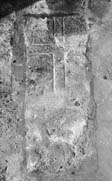Select a site alphabetically from the choices shown in the box below. Alternatively, browse sculptural examples using the Forward/Back buttons.
Chapters for this volume, along with copies of original in-text images, are available here.
Object type: Grave-cover or -marker
Measurements: L. 71 cm (28 in) W. 28 > 27 cm (11 > 10.6 in) D. Built in
Stone type: [Upper Lincolnshire Limestone, Inferior Oolite Group, possibly Ancaster Freestone]
Plate numbers in printed volume: Ill. 65
Corpus volume reference: Vol 5 p. 115-116
(There may be more views or larger images available for this item. Click on the thumbnail image to view.)
A plain almost rectangular slab decorated on its only visible face with an incised outline cross.
A (broad): The cross is of type A1 and is formed by broadly incised parallel lines of V-section. The head and arms of the cross extend to the boundaries of the stone, but the stem terminates at a point somewhat below the centre of the slab, even though the remainder of the surface is dressed.
It is the termination of the cross near the centre of the stone, along with its small size, that casts uncertainty on this slab's function. Although most easily interpreted as a small grave-cover, this feature does allow its interpretation as an upright marker, of which the lower portion was to be buried. Simple incised crosses of this character are found on covers at Carlby (no. 1), Lincoln St Mark (nos. 6, 9 and 19) and Wilsford (no. 1), and on the possible marker at Ropsley (no. 1).
Carlby 2, 3 and 4 employ the same technique but have crosses of type B6, as does the cover at Castle Bytham (no. 1). Such covers are found throughout the East Midlands, and indeed elsewhere; for example there is a similar cover north of the chancel at Castor in the Soke of Peterborough. The simplicity of the design makes this type of cross very hard to date; however, where it appears along with other datable motifs (as e.g. at Ewerby or Lincoln St Mark 6), it can be dated to between the late tenth and the early twelfth centuries.



